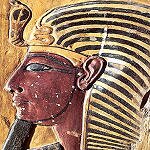|
|
|||||||
|
|
Pages in this article: [ THE LIFE OF RAMESSESS THE GREAT ] Ramesses the god
Ramesses knew what was required to be a great pharaoh, a brave warrior, a mighty builder, an educated scribe, and an effective priest. Ramesses had already fulfilled the first requirement and had all his victorious campaigns carved into the walls of the most public monuments exaggerating his achievements. The battle of Kadesh was re-enacted on at least nine national monuments, which included the temples of Karnak, Luxor, Abu Simbel, and the Ramesseum.
In addition to the city being one of beauty with its palaces, temples and its spatial residential districts, it was a garrison city, housing numerous troops, who were on a constant state of readiness, allowing Ramesses to easily counteract any military interventions from the east i.e. the growing power of the Assyrians. Ramesses never abandoned the traditional role of pharaoh travelling up and down the length of the Nile, making personal appearances to every corner of his realm, re-assuring and at the same time warning his people that no matter where they lived, nothing could happen without him knowing about it. What drove Ramesses to construct and dedicate more monuments in his own honour than any of his predecessors?
Pharaoh, albeit a semi-divine being, also displayed normal human vanities and insecurities. He wanted to prove to his people and the gods that he was worthy of his divine status and was better than his predecessor. In order to prove their worthiness, the kings would ensure that their achievements were celebrated for eternity by having their names, titles, and deeds carved in stone throughout the land. A stele from the New Kingdom expresses this doctrine: "Publish your deeds throughout the world so that all may congratulate you."
|
||||||

|
|||||||
|
|||||||






 Seti I had died around 1279 BC at the age approximate age of 50, leaving Ramesses, now 25, to inherit the divine title of Pharaoh. His mother Tuya was still alive and well, she would continue to be by her son's side as a confidant and advisor who was to command considerable influence at court. Although crowned king, he was haunted by the fact that he was not of the royal bloodline. To overcome this he strove to prove that he was worthy of the title and consciously built up a reputation as an extraordinary being with divine destiny.
Seti I had died around 1279 BC at the age approximate age of 50, leaving Ramesses, now 25, to inherit the divine title of Pharaoh. His mother Tuya was still alive and well, she would continue to be by her son's side as a confidant and advisor who was to command considerable influence at court. Although crowned king, he was haunted by the fact that he was not of the royal bloodline. To overcome this he strove to prove that he was worthy of the title and consciously built up a reputation as an extraordinary being with divine destiny. It was in the next category that Ramesses was to excel. As soon as he was inaugurated, Ramesses announced that the capital city was to move! The site of the new city was to be Seti's summer palace near Avaris. This new city was to be called Pi (or Per) Ramesse Aa-nakhtu, meaning "House of Ramesses - great of victories". Was this yet another pharaoh trying to imitate Akhenaten's vision? No, this move may have been taken with military undertones.
It was in the next category that Ramesses was to excel. As soon as he was inaugurated, Ramesses announced that the capital city was to move! The site of the new city was to be Seti's summer palace near Avaris. This new city was to be called Pi (or Per) Ramesse Aa-nakhtu, meaning "House of Ramesses - great of victories". Was this yet another pharaoh trying to imitate Akhenaten's vision? No, this move may have been taken with military undertones. To understand this question we firstly have to understand the concept of Egyptian monuments. They were not just national monuments but considered a direct link between the semi-divine being and the divine. By erecting the temples, pharaoh was servicing and attending to the gods needs. If the gods were happy they would continue to keep chaos at bay and the cosmic law and order known as Ma'at would prevail. By association, if the gods were happy, then Egypt and her people were happy, this onerous responsibility was attributed to one person - pharaoh.
To understand this question we firstly have to understand the concept of Egyptian monuments. They were not just national monuments but considered a direct link between the semi-divine being and the divine. By erecting the temples, pharaoh was servicing and attending to the gods needs. If the gods were happy they would continue to keep chaos at bay and the cosmic law and order known as Ma'at would prevail. By association, if the gods were happy, then Egypt and her people were happy, this onerous responsibility was attributed to one person - pharaoh.